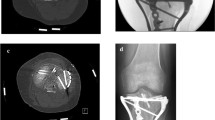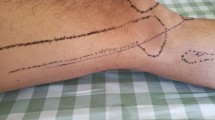Abstract
Introduction
Hoffa fractures are uni- or bicondylar fractures of the distal femur in a coronal tangential plane.
Case Presentation
We report the case of an isolated, low energy, closed, displaced, lateral femoral condyle Hoffa fracture in a 54 year old Caucasian man. This was treated by open reduction and internal fixation using two headless compression screws. At 1 year review the patient was pain free, the fracture had radiographically united and there was a range of movement to his knee of 0°–100°.
Discussion
Traditional methods of fixation for Hoffa fractures have led either to the application of complicated constructs attempting to achieve stability, or to large articular surface defects created whilst countersinking headed lag screws. Both have negative implications for the patient. We describe a novel method, not previously described in the literature, using screws in a posterior to anterior direction. This provides compression perpendicular to the fracture site whilst protecting against shear and torsional forces, thereby providing more stable fixation. Furthermore, our method allows for a minimally invasive approach and uses headless compression screws, which reduces the chance of damage to the articular surface and is, therefore, less physiologically invasive.



Similar content being viewed by others
References
Agarwel S, Giannoudis P, Smith R. Cruciate fracture of the distal femur: the double Hoffa fracture. Injury. 2004;35:828–30.
Jarit G, Kummer F, Gibber M, Egol K. A mechanical evaluation of two fixation methods using cancellous screws for coronal fractures of the lateral condyle of the distal femur (OTA 33B). J Orthop Trauma. 2006;20(4):273–6.
Letenneur J, Labour P, Rogez J, et al. Hoffa’s fractures––report of 20 cases (author’s transl) [French]. Ann Chir. 1978;32(3–4):213–9. (Eng. Abst).
O’Brien P. Fractures of the distal femur. In: Bucholz R, Heckman J, Court-Brown C, et al., editors. Rockwood and Green’s fractures in adults. Philadelphia: Lippincott Williams & Wilkins; 2005. p. 1915–67.
Baker B, Escobedo E, Nork S, Henley M. Hoffa fracture––a common association with high energy supracondylar fractures of the distal femur. Am J Roentgenol. 2002;178:994.
Heyschen U, Gohring U, Meeder P. Bilateral Hoffa fracture: a rarity. Aktuelle Traumatol. 1994;24(3):83–6.
Lewis S, Pozo J, Muirhead-Allwood W. Coronal fractures of the lateral femoral condyle. J Bone Joint Surg. 1989;71-B:118–20.
Westmoreland G, McLaurin T, Hutton W. Screw pullout strength: a biomechanical comparison of large-fragment and small-fragment fixation in the tibial plateau. J Orthop Trauma. 2002;16(3):178–81.
Karunaker M, Egol K, Peindl R, et al. Split depression tibial plateau fractures. A biomechanical study. J Orthop Trauma. 2002;16(3):172–7.
Conflict of interest statement
No funds were received in support of this study. No benefits in any form have been or will be received from a commercial party related directly or indirectly to the subject of this manuscript.
Author information
Authors and Affiliations
Corresponding author
Rights and permissions
About this article
Cite this article
Borse, V., Hahnel, J. & Cohen, A. Hoffa fracture: fixation using headless compression screws. Eur J Trauma Emerg Surg 36, 477–479 (2010). https://doi.org/10.1007/s00068-010-0014-0
Received:
Accepted:
Published:
Issue Date:
DOI: https://doi.org/10.1007/s00068-010-0014-0




